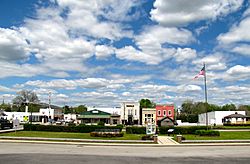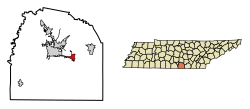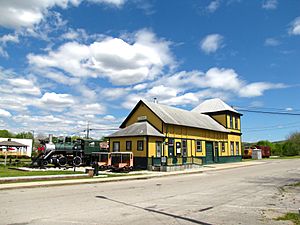Cowan, Tennessee facts for kids
Quick facts for kids
Cowan, Tennessee
|
|
|---|---|

Businesses along Tennessee Avenue
|
|

Location of Cowan in Franklin County, Tennessee.
|
|
| Country | United States |
| State | Tennessee |
| County | Franklin |
| Area | |
| • Total | 2.08 sq mi (5.38 km2) |
| • Land | 2.08 sq mi (5.38 km2) |
| • Water | 0.00 sq mi (0.00 km2) |
| Elevation | 974 ft (297 m) |
| Population
(2020)
|
|
| • Total | 1,759 |
| • Density | 846.49/sq mi (326.84/km2) |
| Time zone | UTC-6 (Central (CST)) |
| • Summer (DST) | UTC-5 (CDT) |
| ZIP code |
37318
|
| Area code(s) | 931 |
| FIPS code | 47-17700 |
| GNIS feature ID | 1306151 |
Cowan is a small city in Franklin County, Tennessee, in the United States. In 2020, about 1,759 people lived there. It's part of the wider Tullahoma area.
History of Cowan
The first people settled in the Cowan area a long time ago, in the late 1700s and early 1800s. One early settler, William Russell, even had his home used as the Franklin County Courthouse for a while. This was before the town of Winchester was founded in 1810.
The town of Cowan got its name from Dr. James Benjamin Cowan. His family had lived in the area since the early 1800s, and he was a doctor during the Civil War.
Cowan really started to grow in the mid-1800s because of the railroad. It became an important railroad town. Several smaller train lines met the main line that went from Nashville to Chattanooga. This main line also passed through the famous Cowan Tunnel.
Cowan was the last stop before trains had to climb a steep hill onto the nearby Cumberland Plateau. Because of this, special "pusher engines" were kept in Cowan. These engines would help push trains up the big hill. They are still used today!
Later, in the 1940s, a new road called U.S. Route 41A was built. This made the railroad less important, and the town's economy slowed down. However, the old passenger train station, built in 1904, has been restored. It is now a museum and a main spot in downtown Cowan.
Where is Cowan?
Cowan is located at 35°10′0″N 86°0′43″W / 35.16667°N 86.01194°W. It sits at the western base of the Cumberland Plateau. The city is mostly found where U.S. Route 41A crosses the CSX railroad tracks.
The edge of the Plateau forms several small valleys nearby, like Hawkins Cove and Keith Cove. Boiling Fork Creek flows through Cowan and eventually joins the Elk River.
US 41A is the main road in Cowan. It connects the city to Winchester and the Tims Ford Lake area to the west. East of Cowan, US 41A climbs almost 1,000 feet (300 m) to the top of the Cumberland Plateau. There, it passes through towns like Sewanee and Monteagle.
The United States Census Bureau says that Cowan covers about 2.0 square miles (5.2 km2) of land. There is no water area within the city limits.
People in Cowan
| Historical population | |||
|---|---|---|---|
| Census | Pop. | %± | |
| 1880 | 222 | — | |
| 1890 | 624 | 181.1% | |
| 1930 | 1,367 | — | |
| 1940 | 1,461 | 6.9% | |
| 1950 | 1,835 | 25.6% | |
| 1960 | 1,979 | 7.8% | |
| 1970 | 1,772 | −10.5% | |
| 1980 | 1,790 | 1.0% | |
| 1990 | 1,738 | −2.9% | |
| 2000 | 1,770 | 1.8% | |
| 2010 | 1,737 | −1.9% | |
| 2020 | 1,759 | 1.3% | |
| Sources: | |||
In 2020, the city of Cowan had 1,759 people living there. There were 624 households and 341 families. The community is made up of people from many different backgrounds.
Famous People from Cowan
- Jauan Jennings – A former football player for the University of Tennessee and the San Francisco 49ers.
- Mary Ann Montgomery – She was the wife of Confederate Army General Nathan Bedford Forrest.
See also
 In Spanish: Cowan (Tennessee) para niños
In Spanish: Cowan (Tennessee) para niños


